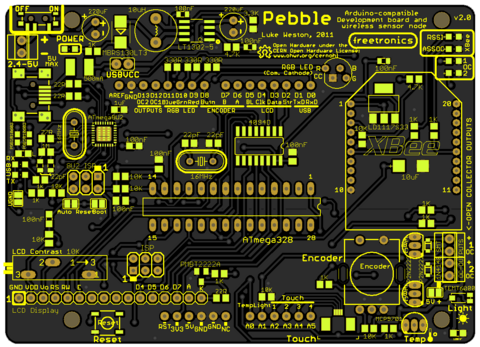Difference between revisions of "Main Page"
(→Hardware Assembly Project: KitTen) |
(→Hardware Assembly Project: Pebble V2.0) |
||
| Line 18: | Line 18: | ||
The "Pebble" v1 board was designed by Luke Weston for the very first Arduino Miniconf in January 2010. The first version was implemented as a "shield" to be fitted to a regular Arduino, but Luke's latest design incorporates a complete functional Arduino-compatible board into a single unit. | The "Pebble" v1 board was designed by Luke Weston for the very first Arduino Miniconf in January 2010. The first version was implemented as a "shield" to be fitted to a regular Arduino, but Luke's latest design incorporates a complete functional Arduino-compatible board into a single unit. | ||
| − | The new design incorporates a number of surface-mount parts, so those will be pre-fitted prior to the Miniconf. Attendees will only need to fit standard "through-hole" parts, so the soldering skill required is minimal. This project is therefore suitable for a beginner, even though the end result will be a very capable board. | + | The new design incorporates a number of surface-mount parts, so those will be pre-fitted prior to the Miniconf. Attendees will only need to fit standard "through-hole" parts, so the soldering skill required is minimal. This project is therefore suitable for a beginner, even though the end result will be a very capable board. It may look scary and complicated when you see the PCB design below, but don't worry, most of the parts will already be on the board. |
[[File:Pebble-top.png|480px]] | [[File:Pebble-top.png|480px]] | ||
Revision as of 09:44, 22 December 2011
Contents
Arduino Miniconf 2012
What
The Arduino Miniconf is a 1-day event that runs in conjunction with the linux.conf.au conference. It gives participants an opportunity to learn basic soldering by assembling their own Arduino-compatible board, and then the afternoon is filled with interesting talks about various projects and techniques related to Arduino and open hardware in general.
When
Monday, January 16th, 2012.
Where
Ballarat, as part of linux.conf.au. Note that to attend you must first register for the main conference, which provides the venue.
Registration
Attendance is free (to delegates to linux.conf.au) but if you wish to participate in the hardware assembly tutorial you will need to purchase a kit. Space is limited so get in fast! If you just want to come along and watch or attend the talks, you don't need to do anything. If you wish to participate in the hardware assembly tutorial, please submit the registration form here:
Hardware Assembly Project: Pebble V2.0
The "Pebble" v1 board was designed by Luke Weston for the very first Arduino Miniconf in January 2010. The first version was implemented as a "shield" to be fitted to a regular Arduino, but Luke's latest design incorporates a complete functional Arduino-compatible board into a single unit.
The new design incorporates a number of surface-mount parts, so those will be pre-fitted prior to the Miniconf. Attendees will only need to fit standard "through-hole" parts, so the soldering skill required is minimal. This project is therefore suitable for a beginner, even though the end result will be a very capable board. It may look scary and complicated when you see the PCB design below, but don't worry, most of the parts will already be on the board.
Hardware Assembly Project: KitTen
The "KitTen" is a kit-based Arduino-compatible board that uses an FTDI cable to upload new sketches from your computer.

